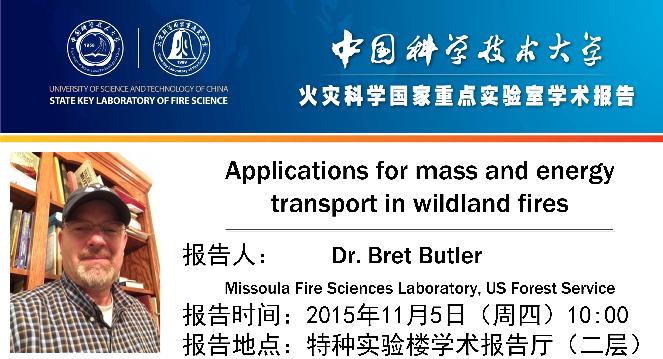| homepage News and Events Seminars |
| Applications for mass and energy transport in wildland fires |
| Date: 2015-11-03 Author: Source: |
Title: Applications for mass and energy transport in wildland fires Speaker: Dr. Bret Butler From: Missoula Fire Sciences Laboratory, USA Date: Nov. 05, 2015 10:00-11:30
CV of the Speaker:
Dr. Bret Butler is currently employed as a Research Mechanical Engineer in the Fire Fuels and Smoke Research Work Unit at the US Forest Service Fire Sciences Laboratory in Missoula, MT. His research focuses primarily on experimental characterization of fundamental heat and combustion processes in wildland fire. His research is primarily experimental, but also has application to fire behavior modeling, links between fire behavior and its effects on flora, high resolution surface wind modeling, and firefighter safety. Dr. Bret Butler holds Ph.D. in Mechanical Engineering from Brigham Young University (1992) where he studied energy transport in particle laden flames. He has authored more than 96 technical papers, and 22 peer-reviewed technical papers. He has been directly responsible for securing more than a million dollars in funding for research projects and have been a primary investigator, co-investigator or major contributor to another $2,400,000 in research funding grants. In current research assignment Dr. Bret Butler supervises a team of 4-6 engineers and foresters. This team focuses on exploring the physics and chemistry of wildland fire in all vegetation types through experimental testing, computer modeling, and theoretical analysis to develop new understanding of fire that will improve our ability to predict fire spread and intensity. This team develops and tests new theory of heat transfer in flames that informs new and improved national wildland firefighter safety zone guidelines. They have improved understanding of how wind flows over terrain and the primary variables critical to fine resolution surface wind flow in order to increase the predictive accuracy of wildland fire management decision support systems. Dr. Bret Butler has worked in Forest Service fire research for nearly twenty years. Dr. Bret Butler has been a member of the editorial advisory board of the International Journal of Wildland Fire (IJWF) since 2000. During 2002-2004 Dr. Bret Butler was invited to chair the editorial advisory board of IJWF. From 1998 to present, Dr. Bret Butler has held the Associate editor for the IJWF.
Abstract: Wildland fire remains a complex and poorly understood phenomenon. Current research foci include energy transport, fire/atmosphereinteraction, live vegetation ignition, and fire effects on flora, fauna and atmosphere. This seminar will present a snapshot of recent research on the first two topics. With respect to energy transport, traditionally radiant energy exchange has been assumed to be the primary mode of energy transport in wildland fires. Recent measurements suggest that convective heat flux is also critical to fire spread. It is composed of brief/intense peaks and troughs associated with the passage of hot and cold air whereas radiation heat flux is much less variable in time, increasing and decreasing nearly monotonically with the approach, arrival and departure of the flame front. Generally, radiant fluxes are highest in crown fires and vary between 190 and 300 kW/m2. Convective energy fluxes varied substantially with fuel type and fire classification. For example, crown fires in lodgepole pine (Pinus contorta) resulted in convective fluxes on the order of 25% of the peak radiant fluxes. However, fires in surface fuels characteristic of southern longleaf pine (Pinus palustris) ecosystem showed convective fluxes that were on the order of the radiant fluxes and in some cases exceeded the radiant flux. With respect to fire/atmosphere interaction, we are just beginning to develop methods for simulating near surface wind flow at high spatial resolution. Wind is one of the most influential environmental factors affecting wildland fire behavior. Traditionally, fire managers have relied on expert judgment, point measurements, or weather forecasts to estimate local winds. These methods can lead to large errors in estimated wind speed and direction especially in complex terrain. When considering models that can be used Bret Butler海报.pdf |
|
|
||
|
|
| Relevant link | ||
|
|
|
||||||||||
|
||||||||||
